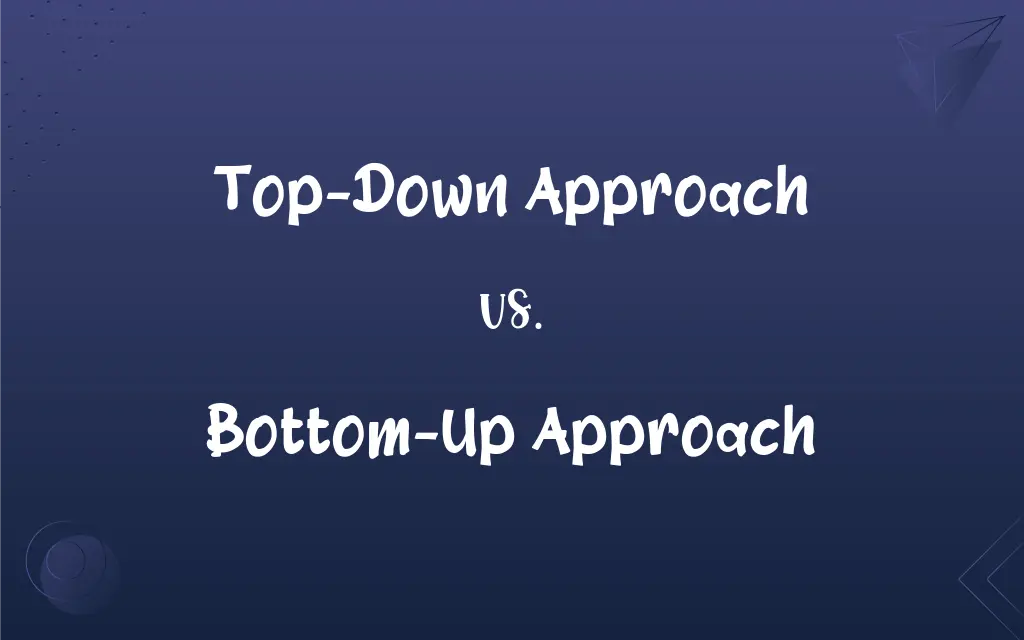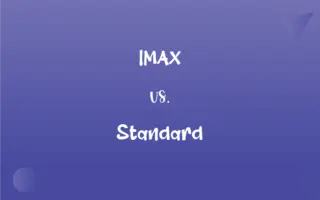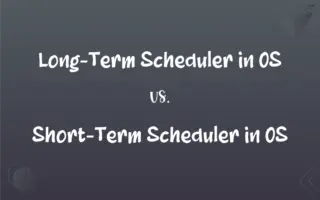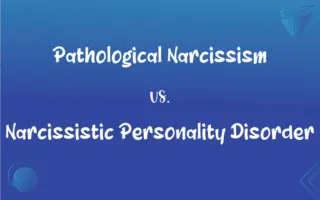Top-Down Approach vs. Bottom-Up Approach: What's the Difference?
Edited by Aimie Carlson || By Janet White || Published on February 11, 2024
Top-down approach starts with overarching principles and breaks them down into specifics, while bottom-up builds from specific details to a general view.

Key Differences
The top-down approach begins with a broad, general perspective and then drills down into the details. It's akin to starting with a wide lens and then zooming in. In contrast, the bottom-up approach takes the opposite route. It starts with specific, individual elements and gradually builds up to form a comprehensive picture. This approach is like assembling a puzzle, starting with individual pieces to create the whole image.
In a top-down approach, decisions and directions often come from higher levels of authority or overarching frameworks, trickling down to the specifics. It emphasizes a hierarchical flow of information and control. Conversely, the bottom-up approach is more democratic and grassroots in nature. It values input and insights from the ground level, aggregating these to form broader strategies or conclusions.
When implementing a strategy, a top-down approach would mean setting the goals first and then determining the steps to achieve them. This approach often relies on established theories or models. On the other hand, the bottom-up approach would involve starting from practical, ground-level actions and experiences, and from these, deriving broader goals or theories.
In problem-solving, a top-down approach breaks down a large problem into smaller, more manageable parts to address each specifically. Meanwhile, the bottom-up approach gathers specific data or observations and synthesizes them to understand the larger issue.
In terms of organizational structure, the top-down approach aligns with traditional hierarchical organizations where decision-making is centralized. In contrast, the bottom-up approach resonates with flat or decentralized organizational structures, where decision-making is often collaborative and distributed among various members or levels.
ADVERTISEMENT
Comparison Chart
Initiation
Originates from higher levels or overarching concepts.
Starts from ground-level details or specific instances.
Decision Making
Decisions are made by higher authorities and passed down.
Decisions emerge from grassroots level, building upwards.
Problem Solving
Breaks down complex problems into smaller parts.
Builds understanding from specific observations to generalizations.
Organizational Structure
Aligns with hierarchical systems with centralized control.
Suits flat or decentralized structures with collaborative input.
Planning and Strategy
Begins with goals or end results, then plans steps.
Starts with specific actions, leading to broader goals.
ADVERTISEMENT
Top-Down Approach and Bottom-Up Approach Definitions
Top-Down Approach
It is a hierarchical process where decisions flow from the top to the bottom layers.
In a top-down approach, the CEO’s vision for the company drives departmental strategies.
Bottom-Up Approach
It emphasizes starting from ground-level data or experiences to form broader conclusions.
Using a bottom-up approach, a researcher analyzes case studies to develop a theory.
Top-Down Approach
In a top-down approach, broad policies or rules are established before specific applications are considered.
The government’s top-down approach involves setting national policies before local implementation details.
Bottom-Up Approach
Bottom-up approach involves building complex systems from simple components.
A bottom-up approach in learning begins with mastering basic concepts before tackling complex topics.
Top-Down Approach
This approach initiates from a macro perspective, gradually focusing on micro elements.
Using a top-down approach, a teacher explains the theory before demonstrating specific examples.
Bottom-Up Approach
This approach prioritizes grassroots input for decision-making and planning.
A bottom-up approach in community development involves residents' opinions in planning projects.
Top-Down Approach
It's a method where higher-level concepts guide the breakdown into lower-level tasks.
A top-down approach in writing involves outlining the thesis first, then elaborating each section.
Bottom-Up Approach
It's a method where specific instances inform and shape overall strategy or theory.
In software development, a bottom-up approach starts with writing individual modules before integrating them.
Top-Down Approach
Top-down approach is a strategy that starts with a general overview and then addresses specific components.
In a top-down approach, a company sets its annual objectives before departmental goals are determined.
Bottom-Up Approach
Bottom-up approach starts with specific details, building towards a general framework.
In a bottom-up approach, gathering individual customer feedback helps shape the product strategy.
FAQs
What's an example of a bottom-up approach?
A community-driven initiative where local inputs shape a project is an example.
Can you give an example of a top-down approach?
An example is a government setting policies that local agencies implement.
What is a top-down approach?
It's a strategy that begins with overarching concepts and then focuses on specific details.
What does a bottom-up approach entail?
It involves starting from specific details or data, building up to a general conclusion.
How do these approaches impact organizational culture?
Top-down can lead to a more controlled culture, while bottom-up fosters collaboration.
How does decision-making differ in these approaches?
In top-down, decisions are made by higher-ups; in bottom-up, decisions emerge from the grassroots level.
Is top-down approach more efficient than bottom-up?
Efficiency depends on the context; top-down can be quicker but might lack grassroots insights.
Can these approaches be combined?
Yes, many situations benefit from a hybrid of both approaches.
How does a top-down approach affect innovation?
It can streamline innovation but may limit creative input from lower levels.
Does a bottom-up approach encourage creativity?
Yes, it often fosters innovation by valuing diverse grassroots ideas.
Does bottom-up approach require more time?
It can be more time-consuming due to the need for collective input and consensus.
How does a top-down approach affect employee morale?
It can lead to a sense of control, potentially reducing individual initiative.
Can a bottom-up approach improve employee engagement?
Yes, as it values and incorporates employee input, enhancing engagement.
Are there risks with a top-down approach?
Yes, risks include lack of adaptability and missing out on ground-level insights.
In what scenario is a bottom-up approach preferred?
It's preferred when individual or local insights and participation are crucial.
Is top-down approach more suitable for large organizations?
Often yes, as it helps maintain control and direction in large-scale operations.
How does bottom-up approach impact small teams?
It can be highly effective in small teams, promoting collaboration and shared responsibility.
What are the challenges of a bottom-up approach?
Challenges include potential for disorganization and slower decision-making.
Is one approach better than the other?
Neither is universally better; the best approach depends on the specific context and goals.
Is top-down approach hierarchical?
Yes, it's typically aligned with hierarchical structures.
About Author
Written by
Janet WhiteJanet White has been an esteemed writer and blogger for Difference Wiki. Holding a Master's degree in Science and Medical Journalism from the prestigious Boston University, she has consistently demonstrated her expertise and passion for her field. When she's not immersed in her work, Janet relishes her time exercising, delving into a good book, and cherishing moments with friends and family.
Edited by
Aimie CarlsonAimie Carlson, holding a master's degree in English literature, is a fervent English language enthusiast. She lends her writing talents to Difference Wiki, a prominent website that specializes in comparisons, offering readers insightful analyses that both captivate and inform.







































































